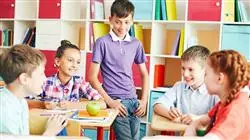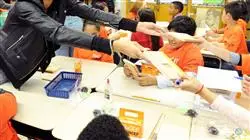University certificate
The world's largest faculty of education”
Introduction to the Program
Intervening at the appropriate stages of the conflict can mean the difference between success or failure in bringing the situation to a point of encounter. This Postgraduate certificate will give you all the tools you need”

This program offers a comprehensive view of conflict resolution in the classroom, as well as successful models of approach, providing tools, experiences and advances in this field, which have also been guaranteed by the program's faculty, as all of them work in this field. Each teacher will learn, based on professional experience as well as evidence-based pedagogy, which makes this program more effective and accurate.
The skills that a mediator possesses are the same as those that the teacher can develop, serving as a mediator between students and the learning process; their intention would be to facilitate the learning process so that students achieve their objectives. Mediation in the educational system is emerging, capable of strengthening, both in teachers and students, a positive point of improvement so the result is to allow both academic and human learning of the relationships that are established in this environment.
The perspective from the emerging educational paradigm must be inclusive and based on a biopsychosocial model that contemplates attention to diversity from a comprehensive approach aimed at the entire educational community.
Teachers, at all educational stages, and related professionals in both the educational and socio-health fields need to know the characteristics of these students, know how to identify their needs and have the knowledge and tools to intervene at a personal, socio-familial and, above all, educational level.
This Postgraduate certificate responds to the demand for continued specialization of educational agents and is aimed primarily at kindergarten, primary, secondary and post-compulsory education teachers. With this educational course, teachers will acquire the skills to manage conflict situations in the classroom and diversity in the context of education, adjust the plans of attention to diversity and the educational projects of the centers, as well as to be able to design a mediation plan in the educational center.
A proprietary, highly skilled Postgraduate certificate that will propel you to the highest level of competitiveness in the teaching market”
This Postgraduate certificate in Conflict Phases and Resolution in the Classroom contains the most complete and up-to-date educational program on the market. The most important features include:
- The latest technology in online teaching software
- Intensely visual teaching system, supported by graphic and schematic contents, easy to assimilate and understand
- Practical cases presented by practising experts
- State-of-the-art interactive video systems
- Teaching supported by telepractice
- Continuous updating and recycling systems
- Autonomous learning: full compatibility with other occupations
- Practical exercises for self-evaluation and learning verification
- Support groups and educational synergies: questions to the expert, debate and knowledge forums
- Communication with the teacher and individual reflection work
- Content that is accessible from any fixed or portable device with an Internet connection
- Supplementary documentation databases are permanently available, even after the program
A practical and realistic program that will provide you with the tools you require to help your students, school staff and families, move forward from conflicts in a positive and enriching way”
Our teaching staff is made up of working professionals. In this way TECH ensures that it delivers the educational update that it aims to. A multidisciplinary team of professors experienced in different environments, who will develop the theoretical knowledge in an efficient way, but above all, will bring their practical knowledge from their own experience to the program: one of the differential qualities of this program.
The efficiency of the methodological design of this master's degree, enhances the student's understanding of the subject. Developed by a multidisciplinary team of e-learning experts, it integrates the latest advances in educational technology. In this way, you will be able to study with a range of comfortable and versatile multimedia tools that will give you the operability you need in your specialization.
The design of this program is centered on: Problem-Based Learning: an approach that conceives learning as an eminently practical process. To achieve this remotely, telepractice will be used: with the help of an innovative system of interactive videos, and learning from an expert you will be able to acquire the knowledge as if you were facing the case you are learning at that moment. A concept that will make it possible to integrate and fix learning in a more realistic and permanent way.
We are not satisfied with just theory: we bring you the most practical and competent expertise”

A contextualized and real educational program that will allow you to put your learning into practice through new skills”
Why study at TECH?
TECH is the world’s largest online university. With an impressive catalog of more than 14,000 university programs available in 11 languages, it is positioned as a leader in employability, with a 99% job placement rate. In addition, it relies on an enormous faculty of more than 6,000 professors of the highest international renown.

Study at the world's largest online university and guarantee your professional success. The future starts at TECH”
The world’s best online university according to FORBES
The prestigious Forbes magazine, specialized in business and finance, has highlighted TECH as “the world's best online university” This is what they have recently stated in an article in their digital edition in which they echo the success story of this institution, “thanks to the academic offer it provides, the selection of its teaching staff, and an innovative learning method aimed at educating the professionals of the future”
A revolutionary study method, a cutting-edge faculty and a practical focus: the key to TECH's success.
The most complete study plans on the university scene
TECH offers the most complete study plans on the university scene, with syllabuses that cover fundamental concepts and, at the same time, the main scientific advances in their specific scientific areas. In addition, these programs are continuously being updated to guarantee students the academic vanguard and the most in-demand professional skills. In this way, the university's qualifications provide its graduates with a significant advantage to propel their careers to success.
TECH offers the most comprehensive and intensive study plans on the current university scene.
A world-class teaching staff
TECH's teaching staff is made up of more than 6,000 professors with the highest international recognition. Professors, researchers and top executives of multinational companies, including Isaiah Covington, performance coach of the Boston Celtics; Magda Romanska, principal investigator at Harvard MetaLAB; Ignacio Wistumba, chairman of the department of translational molecular pathology at MD Anderson Cancer Center; and D.W. Pine, creative director of TIME magazine, among others.
Internationally renowned experts, specialized in different branches of Health, Technology, Communication and Business, form part of the TECH faculty.
A unique learning method
TECH is the first university to use Relearning in all its programs. It is the best online learning methodology, accredited with international teaching quality certifications, provided by prestigious educational agencies. In addition, this disruptive educational model is complemented with the “Case Method”, thereby setting up a unique online teaching strategy. Innovative teaching resources are also implemented, including detailed videos, infographics and interactive summaries.
TECH combines Relearning and the Case Method in all its university programs to guarantee excellent theoretical and practical learning, studying whenever and wherever you want.
The world's largest online university
TECH is the world’s largest online university. We are the largest educational institution, with the best and widest online educational catalog, one hundred percent online and covering the vast majority of areas of knowledge. We offer a large selection of our own degrees and accredited online undergraduate and postgraduate degrees. In total, more than 14,000 university degrees, in eleven different languages, make us the largest educational largest in the world.
TECH has the world's most extensive catalog of academic and official programs, available in more than 11 languages.
Google Premier Partner
The American technology giant has awarded TECH the Google Google Premier Partner badge. This award, which is only available to 3% of the world's companies, highlights the efficient, flexible and tailored experience that this university provides to students. The recognition as a Google Premier Partner not only accredits the maximum rigor, performance and investment in TECH's digital infrastructures, but also places this university as one of the world's leading technology companies.
Google has positioned TECH in the top 3% of the world's most important technology companies by awarding it its Google Premier Partner badge.
The official online university of the NBA
TECH is the official online university of the NBA. Thanks to our agreement with the biggest league in basketball, we offer our students exclusive university programs, as well as a wide variety of educational resources focused on the business of the league and other areas of the sports industry. Each program is made up of a uniquely designed syllabus and features exceptional guest hosts: professionals with a distinguished sports background who will offer their expertise on the most relevant topics.
TECH has been selected by the NBA, the world's top basketball league, as its official online university.
The top-rated university by its students
Students have positioned TECH as the world's top-rated university on the main review websites, with a highest rating of 4.9 out of 5, obtained from more than 1,000 reviews. These results consolidate TECH as the benchmark university institution at an international level, reflecting the excellence and positive impact of its educational model.” reflecting the excellence and positive impact of its educational model.”
TECH is the world’s top-rated university by its students.
Leaders in employability
TECH has managed to become the leading university in employability. 99% of its students obtain jobs in the academic field they have studied, within one year of completing any of the university's programs. A similar number achieve immediate career enhancement. All this thanks to a study methodology that bases its effectiveness on the acquisition of practical skills, which are absolutely necessary for professional development.
99% of TECH graduates find a job within a year of completing their studies.
Postgraduate Certificate in Classroom Conflict Phases and Resolution
If you are passionate about the educational world and would like to improve your skills as a teacher, you can not miss the opportunity to enroll in the Postgraduate Certificate in Classroom Conflict Phases and Resolution. This program gives you the opportunity to learn about the phases that a conflict goes through, which will allow you to anticipate possible stressful situations and handle them appropriately. In the course of the program, you will also learn how to establish aids to move from one phase to another in a conflict, which will allow you to guide your students through conflict situations in a constructive and effective way. In addition, you will learn the different ways to engage in a conflict, which will enable you to adapt your strategy to the particular situation and ensure a successful resolution.
You will develop multiple skills by the end of this program
Another key aspect you will address in this course is arbitration and cooperation in conflicts. These skills will enable you to mediate tense situations and find solutions that benefit all parties involved. In addition, you will learn to foster collaboration and teamwork, which will translate into a more harmonious and productive classroom environment. This Postgraduate Certificate in Classroom Conflict Phases and Resolution is a unique opportunity to improve your teaching skills and enrich your professional career. Through this program, you will acquire fundamental tools to manage conflict situations in an effective and constructive way, which will allow you to provide your students with a more harmonious and conducive educational environment for learning. Do not hesitate any longer and enroll today!







